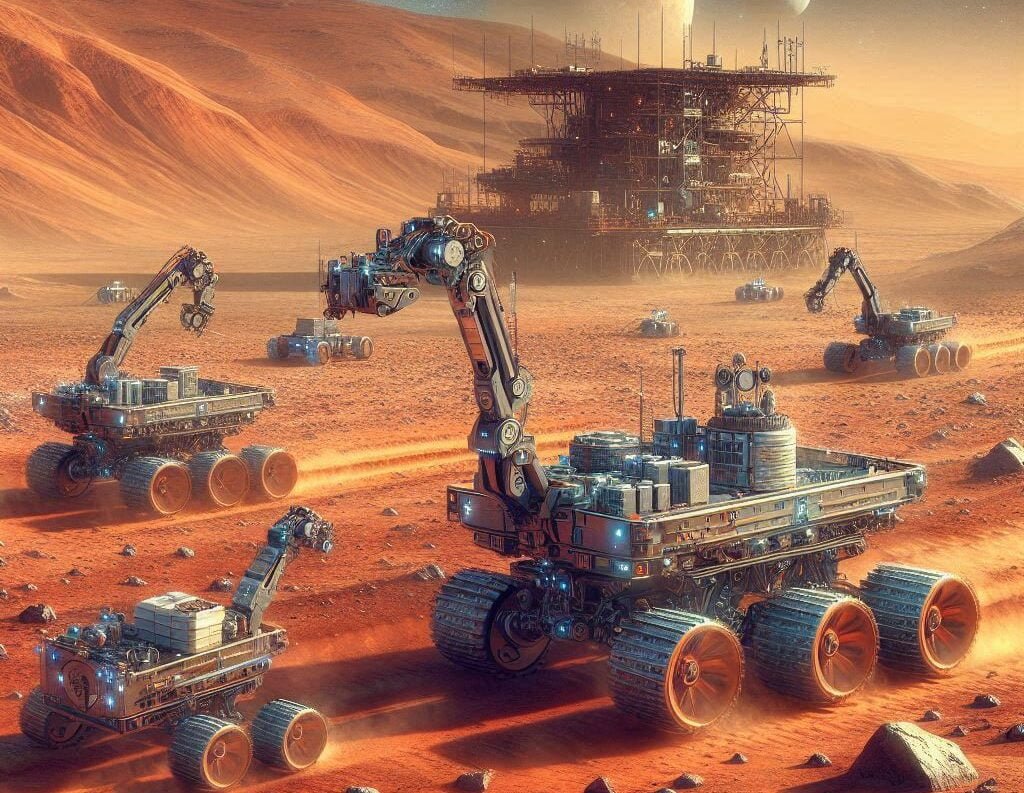Imagine a vast, dusty expanse that stretches as far as the eye can see. This isn’t the set of a sci-fi movie—it’s Mars. In this exploration, titled ‘Will Robots Be Sent To Mars, And What Jobs Will They Do?’, we explore a future where Mars might soon become a bustling hub of robotic activity. As we set our sights on the Red Planet, robots that work on Mars are likely to be the first to carve out a foothold, setting the stage for human explorers. What roles will these robotic pioneers play in such an alien environment? Let’s uncover the possibilities and imagine the future of robotic missions that might turn the stuff of science fiction into reality.
What Jobs Would Be Needed on Mars?
Mars presents a harsh, unforgiving environment, making it an ideal place for robots designed for durability and resilience. Here’s a detailed look at the potential roles robots might play as we aim to conquer this new frontier:
Survey and Mapping

Why is mapping Mars a big deal?
Navigating Mars requires precise maps much like Earth explorers once relied on detailed cartography to traverse unknown territories. Robotic rovers equipped with advanced sensors could chart the Martian terrain, identifying hazards and resources. These robots would serve as pathfinders, creating detailed 3D maps that highlight potential bases and resource deposits, essential for planning future human missions.
Construction and Maintenance
Can robots build Martian bases?
Robots working on Mars could do more than just assist; they could lead construction efforts. Employing autonomous robots to build infrastructure would be crucial, as human presence is still a far-off goal. These robots would use regolith—the loose material covering Mars—to fabricate bricks and other building materials directly on Mars. Imagine robots, working in swarms, autonomously 3D printing a habitat that future astronauts could call home. Their work would not only provide shelter but also test technologies for using Martian resources, paving the way for sustainable human presence.
Scientific Research
What science stuff could robots do?
The scientific potential of Mars is immense, from studying its climate and geology to searching for signs of past life. Robotic scientists could be outfitted with a suite of instruments to perform complex experiments and analyses. These could range from drilling into the Martian crust to analyze subsurface samples, to monitoring the atmospheric conditions that could tell us about Mars’ past habitability and future possibilities.
Agricultural Management

Can robots farm on Mars?
Feeding future Martian colonists will be a critical challenge. Robots could be at the forefront of agricultural efforts, managing hydroponic or aeroponic farms within Martian habitats. They would automate the entire process, from seeding to harvesting, ensuring plants receive the right nutrients and light to thrive in a controlled environment. This would help human missions and also offer information on how to grow crops in space conditions.
Maintenance and Repair
How will robots keep things running smoothly?
The functionality of every piece of equipment on Mars is crucial, and malfunctions could be life-threatening. Maintenance robots would perform regular checks and repairs on everything from habitat structures to scientific instruments. Equipped with diagnostic tools and repair kits, these robots working on Mars would be vital for the longevity and success of the mission, reducing the risk for human explorers.
Environmental Monitoring
Why monitor the Martian environment?
Mars’ environment is less understood and can be unpredictable with its massive dust storms and extreme temperature variations. Robots working equipped with environmental sensors would continuously gather data, helping predict weather patterns and providing early warnings for potential hazards. This continuous stream of data would be invaluable for planning daily activities and long-term strategies for colonization.
Resource Extraction

What about mining—can robots do that on Mars?
Resource extraction will be fundamental to Mars colonization. Robots could be deployed to mine water ice and extract minerals, processes essential for producing water, oxygen, and even fuel for return missions. Additionally, these robotic miners would support human colonies and aid in producing construction materials, which would further enhance the development of Martian infrastructure.
Conclusion
The future of Martian exploration is poised to be robotic. As we prepare to extend our reach beyond Earth, these robotic missions represent the vanguard of our extraterrestrial ambitions. They will lay the groundwork, literally and metaphorically, for generations of human scientists, pioneers, and possibly even permanent settlers.
Call to Action
What are your thoughts about the robotic colonization of Mars? Do you think robots working on Mars are up to the task, or are there elements of Mars exploration you feel would be better handled directly by humans? Join the discussion below and share your views!






